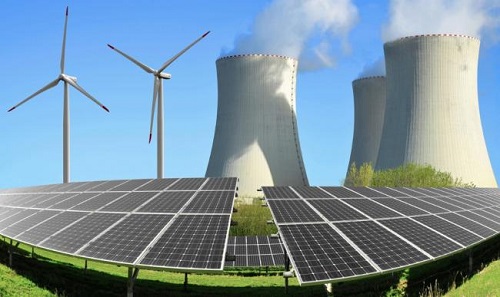
BY STAFF REPORTER
Energy transition refers to the global energy sector’s shift from fossil-based systems of energy production and consumption — including oil, natural gas and coal — to renewable energy sources like wind and solar, as well as lithium-ion batteries.
The increasing penetration of renewable energy into the energy supply mix, the onset of electrification and improvements in energy storage are all key drivers of the energy transition.
Regulation and commitment to decarbonization has been mixed, but the energy transition will continue to increase in importance as investors prioritize environmental, social and governance (ESG) factors.
As more investors and companies seek greater clarity and confidence in accounting for long-term climate risks and opportunities, businesses are adapting to the “energy transition” — a transformation of the global energy sector from fossil-based systems of energy production and consumption to renewable energy sources.
Switching from nonrenewable energy sources like oil, natural gas, and coal to renewable energy is made possible by technological advancements and a societal push toward sustainability. Spurred by structural, permanent changes to energy supply, demand, and prices, the energy transition also aims to reduce energy-related greenhouse gas emissions through various forms of decarbonization.
After years of depending on regulation for growth in the sector, renewable energy sources have become a powerful and cost-effective source of electricity. The costs of both solar and wind have fallen so drastically that in some regions of the U.S., as well as in the U.K. and Europe, wind power has become cheaper than traditional high-carbon energy resources. As costs continue to fall and wind and solar become mainstream, the renewable energy sector will only keep growing and solidify as a strong investment opportunity.
Generating power from renewables is only part of the energy transition. Mass introduction of electric transportation infrastructure and energy storage, coupled with greater usage of technologies to improve energy efficiency, are also driving this movement. As the average cost of lithium-ion batteries has fallen drastically on a mixture of manufacturing economies of scale and technology improvements, companies and consumers alike are increasingly turning to electrification for power transportation, making the transition to electric vehicles (EVs) one of the largest potential areas for electrification. The global EV adoption rate could reach 10%-12.5% by 2025.
Another central factor for renewable energy and electrification (and the energy transition overall) is renewable energy storage, which could solve the production problems many renewable energy technologies face. Though long seen as the missing link between intermittent renewable power and constant reliability, energy storage has begun playing a broader role in the energy transition, with the potential to enable the eventual decarbonization of energy systems. As costs fall, renewable energy storage has the potential for broad use beyond the niche markets in which it is currently employed. Some commercial uses for energy storage are already more economical.
Global regulatory structures in the realm of energy transition have been fairly uneven. In Europe, regulators have taken a leading role in pushing toward a review on how to reach the carbon-neutral economy by launching EU’s net-zero greenhouse gas emissions target for 2050. Many EU countries have been outspoken about their energy and electrification priorities by publicly setting related targets. Led in large part by China, emerging economies are also trying to determine how to increase energy access and sustain development while also transitioning toward cleaner energy sources. In the U.S., there is growing political momentum around lower greenhouse gas-emitting power generation and a clean energy economy.
Together, almost 200 nations have committed to curbing global warming by substantially reducing greenhouse gas emissions; however, the fulfillment of those commitments has varied. Regulation and commitment have been uneven across the global economy, with some nations continuing to grow their emissions despite promises of further decarbonization.
Accounting for the various components of the energy transition and evaluating companies’ preparedness for this shift requires ESG-centric tools. S&P Global’s S&P 500 ESG Index, Risk Atlas and ESG Evaluations, among other ESG solutions, provide investors with the essential intelligence needed to better understand the risks and opportunities related to the energy transition and environmental risk. Overall, the energy transition is central to ESG investing by pushing toward a carbon-neutral economy.
According to International Atomic Energy Agency (IAEA), the importance of nuclear power in helping to stabilize electricity grids and ensure a reliable and low carbon energy flow will increase with the rising share of renewables in the global energy mix, IAEA Director General Rafael Mariano Grossi said at a major climate event today. He also noted that to achieve the goal of displacing fossil fuels, the use of nuclear will need to extend beyond providing electricity and contribute to heating and hydrogen production.
“Nuclear and renewables are the future,” Mr Grossi said at the Ministerial Thematic Forums for the High-Level Dialogue on Energy, discussing ways to reach climate change goals. “The latest “Net Zero by 2050” International Energy Agency report finds nuclear power’s capacity will need to double if we are to displace fossil fuels,” Mr Grossi said. “To achieve this will require innovation and the deployment of advanced reactors.”
According to Grossi, the IAEA provides a wide range of services to national governments, such as capacity building and technical assistance in the area of nuclear technology. The IAEA disseminates analytical tools for energy planning among more than 150 countries and 20 international organizations. It takes a holistic viewpoint, helping countries to develop sound overall energy policies, he said. Therefore, many of these planning tools and reports, such as the recently published publication Transitions to low carbon electricity systems: Key economic and investments trends, are technology-neutral. “This integrated approach to service requires that we see the big picture and know our part,” Mr Grossi said.
Small Modular Reactors (SMR) as an innovation of particular interest to low and middle-income countries, as they have the potential to become a more affordable and more flexible option for communities and industries with smaller grids. The IAEA has recently kicked off an initiative to provide national governments, experts and regulators with integrated Agency-wide support on all aspects of SMR development, deployment and oversight.
The Ethiopian Herald June 27/2021




